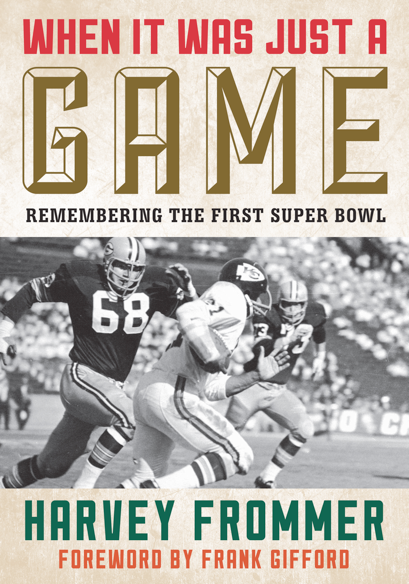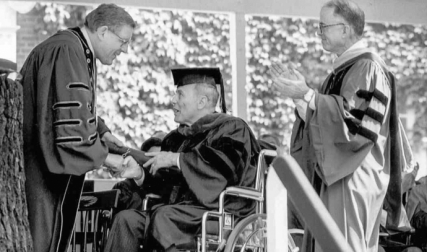 One of NFL Commissioner Pete Rozelle’s suggestions for the name of the new game was “The Big One.” That name never caught on. “Pro Bowl” was another Rozelle idea. Had the name been adopted there would have been confusion, for that was the name used for the NFL’s All Star game. Another name was floated: “World Series of Football.” That died quickly. It was deemed too imitative of baseball’s Fall Classic.
One of NFL Commissioner Pete Rozelle’s suggestions for the name of the new game was “The Big One.” That name never caught on. “Pro Bowl” was another Rozelle idea. Had the name been adopted there would have been confusion, for that was the name used for the NFL’s All Star game. Another name was floated: “World Series of Football.” That died quickly. It was deemed too imitative of baseball’s Fall Classic.
There was no Super Bowl Committee. That, some said, was part of the problem. There was also a game that had no location that had no name. That, too, was part of the problem.
It was Rozelle’s idea to call the contest the AFL-NFL World Championship Game (Los Angeles Times, February 3, 2007).
That name for the game was official. However, it never took off. It was too cumbersome, a mouthful, no good for newspaper headlines.
BOYD DOWLER: We thought it was kind of funny they called it the Super Bowl; that was a feature of the media more than anybody else. But the AFL-NFL Championship Bowl Game, yeah, that’s a lot more words than necessary. Super Bowl is a lot more practical.
SHARON HUNT: The name AFL-NFL championship game was too unwieldy, hard to get straight.
Two days after all the hullabaloo over the AFL-NFL merger, New York Times sports columnist Arthur Daley wrote about what the future held in store: the “new super duper football game for what amounts to the championship of the world.”
The Los Angeles Times reported on September 4, 1966, that the game was being “referred to by some as the Super Bowl.”
The New York Times sports section’s lead story that same day was headlined: “NFL Set to Open Season That Will End in Super Bowl.”
The Washington Post a week later reported: "The brash upstarts who will tackle Goliath in professional football’s ultimate production, a highly appealing ‘Super Bowl’ that promises extra pizzazz at seasons’ end.”
LAMAR HUNT JR: My parents got divorced, and my dad, who was the head of the American Football League, would come over and pick us up. And I remember showing him the Super Ball, the “whammy” super ball and saying, “Hey look, this will bounce over the house, this ball.”
You know my dad was not going to be preoccupied with toys that were given to children. You know, he might have bounced the ball. We just remember demonstrating it.
But then what happened going forward is my dad was in an owner’s meeting. They were trying to figure out what to call the last game, the championship game. I don’t know if he had the ball with him, as some reports suggest.
My dad said, “Well, we need to come up with a name, something like ‘the Super Bowl.’ ”
And then he said, “Actually, that’s not a very good name. We can come up with something better.”
But “Super Bowl” stuck in the media and word of mouth.
It kind of came out of my dad’s mouth. What do you want to call it? Power of suggestion or just an idea or whatever, it stuck. And the inspiration was that Super Ball. I feel blessed to be the son of a guy who really came up with the name. “Super Bowl” was probably inspired by his contact with the Super Ball.
BILL MCNUTT III: I became very close friends with the Hunt children. We would go over to Dallas and I would play with that ball with them. We were just amazed at this ball. It was the most popular toy of its day.
The Wham-O Super Ball was introduced in 1965. Invented by Norm Stingley, a chemical engineer at the Bettis Rubber Company in Whittier, California, the ball was made of Zectron. The Super Ball could bounce six times higher than any regular rubber ball. Millions of the balls were sold, and it remained a craze through the 1960s.
PAUL ZIMMERMAN: The National Football League hierarchy frowned on the term “Super Bowl.” But the fans and the media liked it and used it, and “Super Bowl” would become the name to represent professional football’s championship game.
SHARON HUNT: It was something else: A toy a child was playing with could have inspired the name.
JERRY IZENBERG: The afternoon of the merger the switchboard rang at the NFL offices, and the guy said, “I want 20 tickets for the title game.”
They said, “We don’t even know where it’s going to be.”
And he said, “I don’t care, I want to buy it right now!”
The championship game was not an afterthought to the merger. They were trying to get games played. Even in the merger they negotiated things like, “When will we play exhibition games against each other?”
By October, with the 1966 pro football season at full throttle, a site for the staging of the AFL-NFL Championship Game scheduled for January 8, 1967, still had not been selected. There was agreement by all the members of the NFL site selection committee that the game be played in a warm weather location.
Growing up in Southern California, Rozelle knew January weather there could generally be counted on. He also knew that comfort for the crowd and a game that could be televised were crucial. He also knew that a field where players had solid footing would better showcase the talents of all who played in the game. His reasoning was that a Southern California venue would be fair to all on a field that was not frozen, not impacted by weather.
Arthur Daley of The New York Times agreed: “Under no conditions should this classic-to-be ever be entrusted to the whims of the weatherman. By mid-January, it’s possible that snow in Green Bay or Buffalo might be piled higher than the goalposts.”
Initial prospective sites for the game to be played at included: the Rose Bowl, the Coliseum, the Astrodome, Rice Stadium in Houston, the Sugar Bowl in New Orleans. A few other sites in Texas, Miami and New Orleans also came under consideration.
The committee representing the Rose Bowl objected to its use for a professional football game. Their argument was that it would lessen the prestige of their long running enterprise. However, as time for the playing of that first world championship football game drew closer, Pasadena’s City Council tried to re-enter negotiations with the NFL. It was too late. Anaheim Stadium came on the scene—also too late.
On December 1, 1966, after much wrangling, false starts and all kinds of jockeying about, the game was awarded to the Los Angeles Memorial Coliseum. Two weeks later news broke that NBC and CBS had each signed a four-year, $9.5 million deal for broadcast rights.
On November 7 the Kansas City Chiefs defeated the San Diego Chargers, 24-14, giving them the fast lane to the AFL West crown. Rozelle attended, his first American Football League game.
The clinching of a deal to merge was not official until the NFL received a special antitrust exemption from Congress. Rozelle, driven and charming, pushed a bill through Congress legalizing single-network contracts for pro sports leagues. A new league-wide agreement replaced the individual TV packages of 12 NFL teams.
Some Washington, D.C., legislators had claimed the merger would create an NFL monopoly. There was much lobbying, promises made, and promises broken. Finally, helped by a critical vote by Louisiana Senator Russell, the NFL was given an antitrust exemption. What clinched the deal was a promise by the NFL that its next expansion franchise would be located in Louisiana. That’s how the Saints came marching in.
All the scrambling and shuffling resulted in the creation of never-before-staged TV doubleheader on New Year’s Day. The AFL Championship game from Buffalo was scheduled for 1 p.m., ET. The NFL Championship was slotted to start at 4 p.m., ET, from Dallas.
It was not until the end of December that the league formally announced that the AFL-NFL World Championship game would be played at the Los Angeles Coliseum. The date of the game was changed from January 8 to January 15.
HANK STRAM: The AFL had been lobbying for a championship game from the beginning since we had nothing to lose. The NFL had resisted that idea because they had everything to lose. But by 1966 the difference in quality of the two leagues had narrowed to the point where a playoff game became inevitable.
The name “Super Bowl” was not officially used until the third championship game. The first game in 1967 was officially known as “The NFL-AFL Championship Game.”
However, fans, media and players referred to the first two championships in 1967 and 1968 as the “Super Bowl.” And that it became.
The Roster:
BOYD DOWLER was one of the sport’s great wide receivers. He played 12 seasons for the Green Bay Packers and Washington Redskins. A two-time Pro Bowler and member of the Packers Hall of Fame, he is also a member of the 1960s NFL All-Decade Team.
SHARON HUNT is the daughter of Lamar Hunt. She was at Super Bowl I as a 7-year-old.
LAMAR HUNT, JR. is the son of Lamar Hunt and was at Super Bowl I. The founder of Loretto Properties and Loretto Charities, he is a member of the founding family of the Kansas City Chiefs.
JERRY IZENBERG is one of three daily newspaper columnists to have attended every Super Bowl. Newark Star-Ledger columnist emeritus and a sportswriter for almost 60 years, he is a member of the New Jersey Sports Hall of Fame.
BILL MCNUTT III was a ball boy at the Kansas City Chiefs Training Camp for the Super Bowl I and Super Bowl IV teams. For 50 years he has been an owner of the Collin Street Bakery in Corsicana, Texas, which ships its Christmas cakes to more than 150 countries.
HANK STRAM was the head coach of the Kansas City Chiefs.
PAUL ZIMMERMAN was a sports columnist for the New York Post and Sports Illustrated, and the author of several outstanding books on football.
Harvey Frommer is a noted sports author and oral historian. He has written more than 42 sports books, including Remembering Yankee Stadium, Remembering Fenway Park and the autobiographies of Red Holzman, Nolan Ryan and Tony Dorsett. Cited in the Congressional Record and by the New York State Legislature as a sports historian and journalist, Frommer is a professor in the master of arts in liberal studies program at Dartmouth. He lives in Lyme, New Hampshire, with his wife, Myrna.
Excerpted from When It Was Just a Game by permission of Taylor Trade Publishing, an imprint of Rowman & Littlefield


